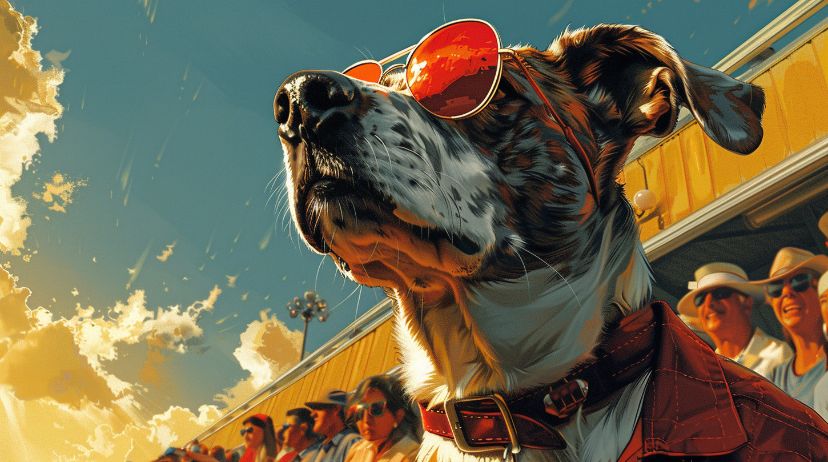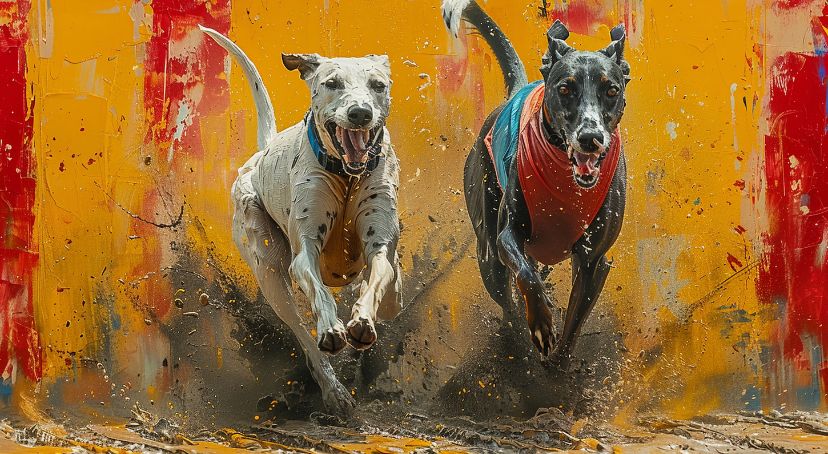In a recent interview, Darrell Williams of Sky Sports Racing has given his insights on Effective Techniques for Selecting a Victorious Greyhound.
What steps can an inexperienced greyhound bettor take to analyse this information effectively and increase their chances of selecting winning bets?
The popularity of greyhound racing for nearly a century can largely be attributed to the consistent performance demonstrated by its participants. When given a clear path and ideal conditions, many greyhounds exhibit minimal variation from one race to another.
However, determining the fastest dog in each race is not a simple task. Greyhounds do not race in designated lanes or on straight tracks, which inevitably leads to bumping and crowding as the runners compete for position.
Nevertheless, not every race is affected by these factors. When experts are asked about the three most crucial factors in predicting the winner of a greyhound race, the most common response is the draw, the draw, and the draw!
The draw refers to the allocation of starting positions for the greyhounds. Individual greyhounds are categorised as railers, middle runners (indicated as 'm' on the racecard), or wide runners ('w' on the racecard) based on how close their running style is to the inside rail.

How would you define Graded and Open races?
To grasp the complexities of greyhound racing, it is essential to understand that there are two main types of races: "Open" races for elite runners and the more common "graded" races. However, there is a considerable overlap between these two categories.
While the highest calibre greyhounds exclusively participate in the top-level Open races, many Opens also feature greyhounds that compete in graded races.
The most significant competitions in Open races are known as Category One events, which can be compared to Group One races in horse racing. Approximately sixty of these races are held each year (indicated as 'OR1' on the racecard), and they attract the highest-class greyhounds. The Greyhound Derby is the most prominent among these events, but there are also other prestigious competitions supported by Premier Greyhound Racing, such as the St Leger and Oaks.
Category One competitions typically consist of three rounds. The qualifiers from the initial round, usually the top three performers, progress to the semi-finals, from which the six finalists are determined. Following Category One races are Category Two competitions (OR2), followed by minor Open race competitions known as Category Three (OR3), and finally, one-off Open races (OR). In all Open races, the racing manager at the hosting track selects the participating greyhounds based on entries received from licensed trainers across the country. Open races often have specific eligibility conditions, such as being limited to puppies, bitches, or British Bred greyhounds.
Graded races, which constitute the majority of races, are contested by greyhounds whose trainers are affiliated with a specific track. The highest grade in these races is 1, with the top-grade race at any track being designated as A1, while the lowest may be A10 or A11.
Some tracks offer a second four-bend race, usually with a slightly shorter distance to the bend, indicated as a 'B' race on the racecard.
Graded sprint races, run over two bends, are denoted with the prefix 'D,' with D1 being the highest grade. Staying races, which involve running over six bends, use the prefix 'S.'
Less commonly used, 'E' races signify marathons that span two laps or longer, and 'H' indicates a hurdle race.
The prefix 'T' is used for trials. For instance, 'T3' indicates a trial race with three runners.
When it comes to trap allocation, there is a fundamental difference between Open races and graded races. In Open races, trap allocation is determined through a random ballot. In graded races, however, the racing manager assigns traps based on a combination of the individual runners' requirements and with the goal of creating a fair and competitive race. This brings us back to the significance of the draw. To maximise their chances of winning, greyhounds need a race setup that provides them with the best opportunity for an uninterrupted run.
How can the racecard be utilised to evaluate which greyhound possesses suitable conditions?
As mentioned previously, the selection of runners for an Open race is based on the entries received. Ideally, these entries would include an equal mix of railers, middle runners, and wide runners, but that is often different.
It is important to note that while some railers prefer to race as close as possible to the inside running rail, others may prefer a racing position that is more similar to lane two or even slightly wider. Considering that middle runners and wide runners have their distinct running characteristics, it becomes evident how significant the draw is in any Open race. For instance, a greyhound that hugs the rails and is drawn in trap one may have a considerable advantage when facing five opponents who are all seeded as middle or wide runners.
In graded races, the race makeup (rails/middles and wides) and how the runners are drawn are determined by the Racing Manager. However, even in these races, well-drawn greyhounds often find winning opportunities. The racing official can only select from the available runners, which may not always result in the optimal distribution of runners.
It is worth looking for greyhounds with an unfamiliar draw, such as a regular trap two runners whose race comments indicate a tendency to edge towards the rails being drawn in trap three. Similarly, a sole wide runner in trap six drawn outside a trap five rival with race comments suggesting a preference for the middle position (usually competing from trap four) can also present an interesting situation to consider.
Why initial speed is essential.
If the greyhound's starting position is crucial to its chances, its initial speed is arguably the second most significant factor, and the saying "early pace wins the race" should always be kept in mind. Experienced bettors often prioritise the greyhound's split time—the duration from the starting traps to the finish line—rather than its final time on the racecard. This is particularly true when evaluating races with four bends. In graded races, the racecard provides multiple lines of form for each runner on the same track and distance, enabling easy comparison of individual split times.
Interest is piqued when a greyhound appears capable of seizing an uncontested lead, such as a railer in trap three whose split times are considerably faster than the two dogs on its inside. Consistency is key, and a greyhound that consistently produces fast split times is more valuable than one that occasionally gets a lucky break.
A consistent pattern of official racing comments indicating "Quickly Away" or "QAw" will quickly draw attention to this type of runner. While they may sometimes be seen as one-dimensional, they often achieve significant success, especially when handicapped at a level below their peak performance. For many experts, "Early Pace" or "EP" is considered an even more desirable attribute. This refers to a greyhound's ability to accelerate noticeably in the initial stages of a race, even if they don't have a particularly fast start from the traps. While competitive split times are still important, the ability to secure a clear path to the turn is considered the most crucial element.
Few things excite and captivate a genuine greyhound enthusiast more than witnessing a top-notch greyhound display a surge of explosive early speed. However, it's important to remember that everything is relative, and any dog, regardless of its skill level, that can accelerate during the run-up will achieve success in numerous races.
While identifying the fastest dogs in terms of early pace in a race can lead to finding many winners, there will always be instances where races are favourable for those with a stronger finishing kick. Dogs that find themselves competing against a field dominated by early pace contenders can be equally valuable in such situations.
Does age and gender matter?
One of the most effective tools for identifying winners is to pay close attention to improving puppies, which refers to greyhounds under two years of age. This is especially true in graded races, where their rapid development can consistently outsmart the handicapper.
Another factor to watch out for is bitches returning from a seasonal rest, particularly when they are approaching 16 weeks after their season date. This is generally considered the time when they reach their peak form. Often, bitches competing in graded races will return at a slightly lower level than their pre-season competition. Once they begin to regain their form, it is a strong indication that they should be taken seriously as contenders. In general, following a bitch in good form, regardless of whether or not they have recently been in season, remains one of the most reliable methods for finding winners in greyhound racing.

Which alternative methods are worth taking into account?
Although greyhound grades are not transferable between tracks, meaning that an A1 winner at one track would struggle to perform well at a different venue with stronger greyhounds, the grading system itself remains effective within each individual track. In essence, if an experienced greyhound is downgraded from A4 to A5, it is generally considered to be more competitive at the lower level. It is advisable to keep an eye out for well-established greyhounds returning to a lower grade, especially if they have a previous winning record at that level.
Trainers who switch to a different track can also present an opportunity for finding winners, particularly if their greyhounds are competing in seemingly weaker races compared to their previous venue. It is wise to be prepared to take action when the kennel starts experiencing a winning streak. Similar considerations apply to graded greyhounds that are transferred to a new trainer at a different track. Some greyhounds simply adapt better to their new surroundings and/or the track they now call home.
Whilst there are various methods to identify winners, if you are serious about cracking the code, nothing can replace the use of your own eyes. Watch as many races as possible, and take note of greyhounds that you believe were unlucky or those you think have a good chance of winning again. It is perfectly fine to specialise in one or two tracks or focus on specific disciplines, such as open race stayers or A1 runners at your preferred track. Regardless of your chosen approach, putting in the effort will yield rewards.

